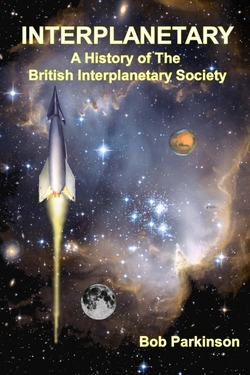Centauri Dreams
Imagining and Planning Interstellar Exploration
Hayabusa 2 Arrives at Ryugu
The asteroid game is heating up. The Japanese probe Hayabusa 2 has arrived at asteroid 162173 Ryugu, the plan being to reach the surface with landers later this year and bring back samples in 2020. We also have ORISIS-REx, launched in 2014, on course to 101955 Bennu in December, with a sample return planned for 2023. Assuming both missions are successful, scientists will have the opportunity to compare the composition of the two. Both are C-type (carbonaceous) asteroids, darker than previously explored asteroid Itokawa. The current Hayabusa is similar to the probe that first returned an Itokawa sample to Earth in 2010.
JAXA confirmed the arrival of Hayabusa 2 at 9:35 (Japan time) on the 27th: “The National Research and Development Corporation Japan Aerospace Exploration Agency (JAXA) announces that we have confirmed the arrival at asteroid Ryugu (Ryugu) of the asteroid explorer ‘Hayabusa 2′”, adding that the distance between the spacecraft and the asteroid is about 20 kilometers.
From a JAXA statement:
The confirmation of the Hayabusa2 rendezvous made at 9:35 a.m. (Japan Standard Time, JST) is based on the following data analyses:
* The thruster operation of Hayabusa2 occurred nominally
* The distance between Hayabusa2 and Ryugu is approximately 20 kilometers
* Hayabusa2 is able to maintain a constant distance to asteroid Ryugu
* The status of Hayabusa2 is normal
Itokawa is an S-type asteroid, so this will be our first chance to sample a C-type, the closest previous encounter with the latter being the NEAR Shoemaker flyby of 253 Mathilde in 1997, which could not close to less than 1000 kilometers. Hayabusa 2 has already released an image of Ryugu from about 40 kilometers out. I liked the way project manager Yuichi Tsuda described the boulder-filled object:
“The shape of Ryugu is now revealed. From a distance, Ryugu initially appeared round, then gradually turned into a square before becoming a beautiful shape similar to fluorite [known as the ‘firefly stone’ in Japanese]. Now, craters are visible, rocks are visible and the geographical features are seen to vary from place to place. This form of Ryugu is scientifically surprising and also poses a few engineering challenges.”
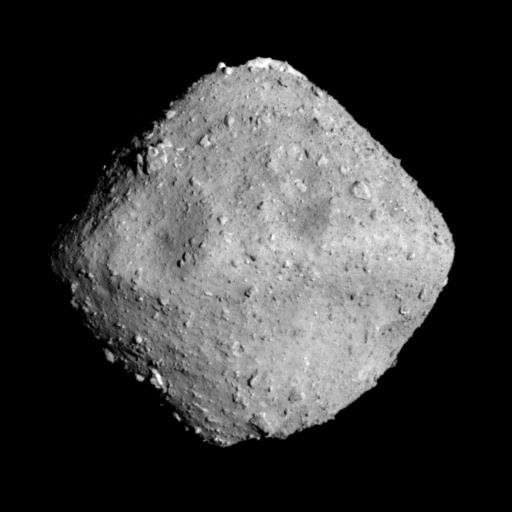
Image: Closing on destination. This is asteroid 162173 Ryugu from a distance of roughly 40 kilometres. The image was taken by the spacecraft’s ONC-T (Optical Navigation Camera – Telescopic) on June 24, 2018 at around 00:01 JST. Credit : JAXA, University of Tokyo, Kochi University, Rikkyo University, Nagoya University, Chiba Institute of Technology, Meiji University, Aizu University, AIST.
I like the idea of a ‘firefly stone,’ and also note that the name Ryugu means ‘dragon’s palace’ in Japanese, giving the imagination plenty to play with. The science payoff from both Ryugu and Bennu could be significant. C-type asteroids are intriguing because they are assumed to be the source of carbonaceous chondrite meteorites and are thought to contain organic material as well as water. With a diameter of about 900 meters and a low-reflectance surface, Ryugu may not win any beauty contests, but it is conceivable that asteroids like this could be sources of water or oxygen that future space missions will tap.
Moreover, asteroids like these are expected to give us insights into objects in the early Solar System, and the samples gained by Hayabusa 2 and its landers should be able to tell us whether the asteroid’s dark surface is as rich in carbon as we assume. Of particular interest is the question of water. The isotopic and chemical analysis of Ryugu should help us gain insights into the formation of Earth’s oceans through incoming asteroids or comets. Landing site selection will be critical as the mission teams plans a 30 cm per second touchdown in October.
Tsuda goes on to note some of the challenges the early imaging is beginning to reveal. While the rotation axis of the asteroid is perpendicular to its orbit, there is a peak near the equator and various small craters, factors that will have to be considered as landing sites are assessed. The object’s unusual shape also introduces some issues:
Globally, the asteroid also has a shape like fluorite (or maybe an abacus bead?). This means we expect the direction of the gravitational force on the wide areas of the asteroid surface to not point directly down. We therefore need a detailed investigation of these properties to formulate our future operation plans.
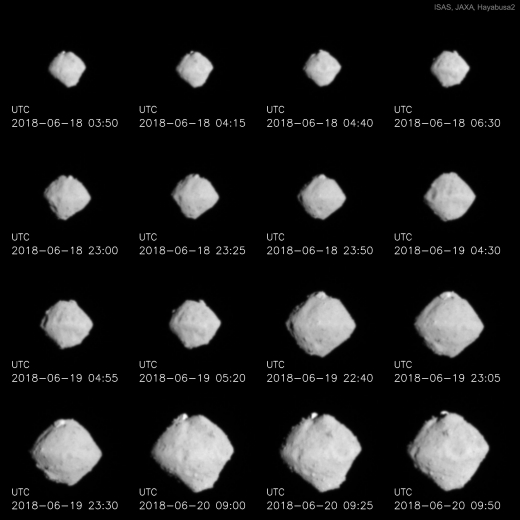
Image: It looks like a big space diamond — but with craters. It’s 162173 Ryugu (Dragon’s Castle), and Japan’s robotic Hayabusa 2 mission is now arriving at this near-Earth asteroid. Ambitious Hayabusa 2 is carrying an armada of separable probes, including two impactors, four small close-proximity hoverers, three small surface hoppers, and the Mobile Asteroid Surface Scout (MASCOT) which will land, study, and move around on Ryugu’s surface. Most of these are equipped with cameras. Moreover, Hayabusa 2 itself is scheduled to collect surface samples and return these samples to Earth for a detailed analysis near the end of 2020. Pictured, a series of approach images shows features suggestive of large boulders and craters. Credit & Copyright: ISAS, JAXA, Hayabusa 2 Team.
Hayabusa 2’s distance from Earth is now 1.9 AU, with a round-trip light time of 1895 seconds.

Exoplanet Hunt: Speeding Up the Data Pipeline
The K2 mission’s C16 and C17 observing campaigns — each containing observations of one patch of the sky for an 80-day period — have proven fruitful for astronomers at MIT. The institution’s Ian Crossfield, working with graduate student Liang Yu, has brought new software tools developed at MIT to work, producing results just weeks after the mission’s raw data for these observing runs were made available. Now we have nearly 80 new exoplanet candidates from C16, but we also have a method of fast analysis that should benefit future missions.
Let’s pause on method. The idea here is to speed up the analysis of light curves, the graphs showing the intensity of light from a star. Between them, C16 and C17 tracked about 50,000 stars, the analysis of whose light would normally take at least several months and perhaps as long as a year. Speed is of the essence because a faster planet identification process makes it possible for quick ground-based radial velocity follow-ups that might otherwise prove challenging.
The reason: K2’s position in a trailing orbit as Earth moves around the Sun means that, depending on its orientation, some stars are not observable by scientists on the ground until the Earth returns to the same patch of sky. So-called ‘rear-facing’ campaigns, as this MIT news release points out, have little need for fast data analysis because the follow-up cannot happen for almost a year. But C16 and C17, in ‘forward facing mode,’ examined stars that remained within Earth’s field of view for several more months. The confirmation process could begin.
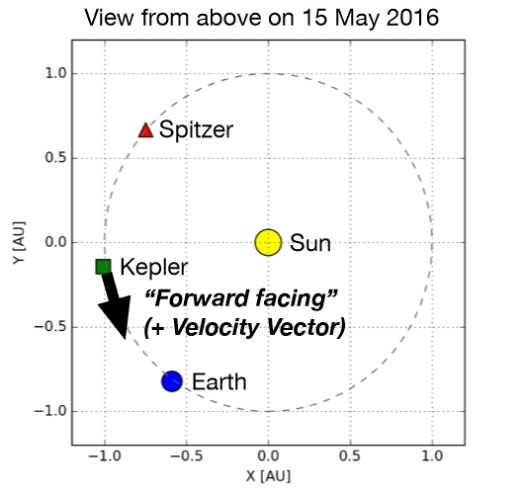
Image: The Kepler Space Telescope, now operating in its K2 extended mission, diagrammed here in ‘forward-facing mode.’ “Forward-facing” implies looking towards Earth in the spacecraft’s orbit, in the direction of the spacecraft’s velocity vector. Credit: This is a slide from a talk by Geert Barentsen and Tom Barclay for the 20th Microlensing Workshop in Paris in 2016.
The researchers’ goal, then, was to work through the light curves, which had been released on February 28, to let their algorithms narrow the field. In the case of C16, which is discussed in a paper on this work in The Astronomical Journal, that means paring 20,647 targets down to 1,097 stars of particular interest. The paper presents a catalog of interesting C16 targets identified through photometry, candidates for rapid identification and follow-up. 30 high-quality planet candidates emerged from the process, along with 48 lower-quality candidates, 164 eclipsing binaries, and 231 other periodically-variable astrophysical sources.
One find stands out as particularly interesting, a planet around the star HD 73344 that orbits its primary every 15 days. HD 73344 is a high proper-motion F6 star, its planet (if confirmed) orbiting the brightest planet host K2 has yet discovered. Crossfield and Yu’s data point to a planet of 2.5 Earth radii and 10 Earth masses circling its star every 15 days — Crossfield refers to it as “a smaller, hotter version of Uranus or Neptune.” At 114 light years from Earth, HD 73344 b could be a prime candidate for atmospheric composition studies.
The paper argues that fast planet searches should be of value for TESS (Transiting Exoplanet Survey Satellite), which will study nearby stars in 30-day periods, ultimately covering 85% of the sky. The data trove from this mission should be enormous, and as it is received, there will be a period of months before the stars examined during that month set for the year. Says Crossfield:
“If we get candidates out quickly to the community, everyone can start immediately observing systems discovered by TESS, and doing a lot of great planetary science. So this [analysis] was really a dress rehearsal for TESS.”
And this is from the paper:
The release of planet catalogs has occurred only irregularly during the K2 mission, but this paradigm will change once TESS operations begin in earnest. Data from TESS will be released and processed on a 27-day rhythm for most of the two-year mission duration. With the shorter observing windows, ephemeris decay is also a much larger problem for TESS and therefore the importance of securing planet candidates in the same season is even higher. If interesting objects could be rapidly gleaned from TESS data and circulated to the community, follow-up observations and analyses could begin a full season earlier and so the full impact of that mission could more quickly be achieved.
As to TESS itself, it’s hard to believe we’re already 68 days past the launch, a period in which the spacecraft has been undergoing commissioning operations before beginning the collection of scientific data.
.@NASA_TESS Mission Update: #TESS continues to operate in its science orbit that was reached in May. In one of the last passes, TESS performed a "break dance:" rotating around to evaluate any stray light sources to characterize camera performance for the duration of the mission.
— NASA_TESS (@NASA_TESS) June 21, 2018
The paper is Yu et al., “Planetary Candidates from K2 Campaign 16,” The Astronomical Journal Vol. 156, No. 1 (21 June 2018). Abstract / preprint.

The Importance of an Eclipsing Charon
The quality of the image below isn’t very high, but consider what we’re looking at. This is the ‘night side’ of Pluto’s moon Charon as viewed against a star field by the New Horizons spacecraft. We’re looking at reflected light from Pluto –‘Plutoshine’ — as the sole illumination of most of the surface. Who would have thought, in the 88 years since Clyde Tombaugh’s discovery of Pluto, that we would see a Plutonian moon’s dark side by Pluto’s light?
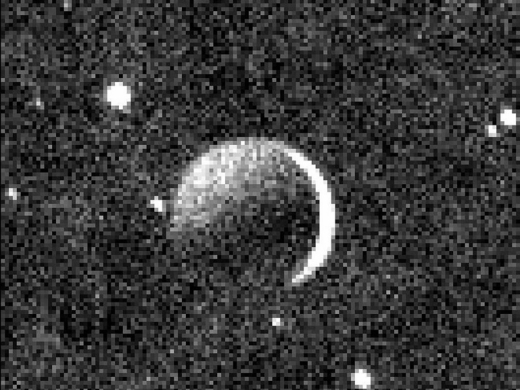
I wonder if there would have been a mission to Pluto at all if it hadn’t been for James Christy. Working with astronomer Robert Harrington at the U.S. Naval Observatory Flagstaff Station (Arizona), Christy was situated just miles away from Lowell Observatory, where Pluto was discovered, when he noticed a strange elongation in images of the world. That was forty years ago, on June 22, 1978, during an effort to tighten up estimates of Pluto’s orbit around the Sun.

I suppose an astronomical analogue to this odd ‘blob’ on Christy’s plates would be the elongation Galileo puzzled over when he looked at Saturn with his earliest optics. In both cases, it would take a bit of imagination and better viewing to make out the real cause, which in Christy’s case was the moon that would be called Charon. It was Christy who proposed the name, and it stuck because the ferryman who carried souls across the river Acheron fit right in with the Plutonian milieu. Acheron was one of five rivers in mythical Pluto’s underworld.
Image: Jim Christy points to the photographic plate on which he discovered Pluto’s largest moon, Charon, in 1978. Credit: U.S. Naval Observatory.
A careful scientist, Christy compared other images to note that the ‘bump’ on Pluto seemed to move from one side to another. Bear in mind that it had been almost a half century since the discovery of Pluto, and in that time no moon had been found. Finding still more images showing an ‘elongated’ Pluto, Christy and Harrington worked out orbital parameters of a moon that could explain what they were seeing, and subjected them to yet more data via a confirmation by the Naval Observatory’s 61-inch telescope. The discovery was announced on July 7, 1978.
And the personal note: We’re told that Christy first chose the name because its first four letters matched the name of his wife, Charlene, known as ‘Char’ to her friends..”A lot of husbands promise their wives the moon,” Charlene Christy would later say, “but Jim actually delivered.”
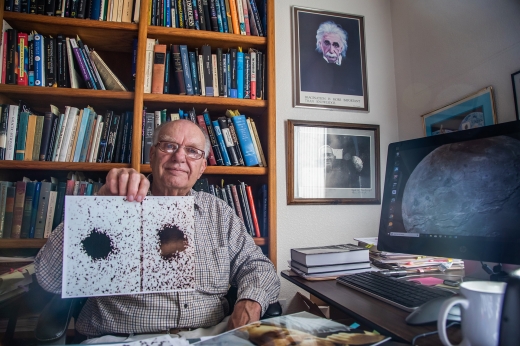
Image: Forty years after his important discovery, Jim Christy holds two of the telescope images he used to spot Pluto’s large moon Charon in June 1978. A close-up photo of Charon, taken by the New Horizons spacecraft during its July 2015 flyby, is displayed on his computer screen. Credit: NASA/Johns Hopkins University Applied Physics Laboratory/Southwest Research Institute/Art Howard/GHSPi.
What a fine tribute that the New Horizons science operations center at JHU/APL, dedicated in 2002, is named after Christy. For the discovery of Charon marked a huge step in getting New Horizons bumped along the difficult terrain of mission approval and launch. Charon is aligned to make eclipses of Pluto possible (for a period of several years) just twice every 248 year Plutonian orbit of the Sun. The eclipses would start in 1985, allowing good science to flow.
Surface brightness could be measured, compositions inferred, possible atmospheres. As David Grinspoon and Alan Stern note in Chasing New Horizons:
In the pantheon of strange and lucky coincidences, the fact that Charon was discovered just before it was about to swing into place for this mutual event season — after all, another such set of eclipses wouldn’t occur for more than a century — is right up there with the grand-tour alignment of the planets appearing just when humans were ready to take advantage of it by mastering spaceflight.
Suddenly a six-year observing window was opening, one that would put Pluto at the top of every major scientific conference, and given the trials of getting New Horizons flown, it’s more than likely that without this string of events, the mission would never have been built. As it is, those of us who were startled to read about Christy’s discovery years ago now have the opportunity to look at images like the one below, showing what we saw then and what we see now.
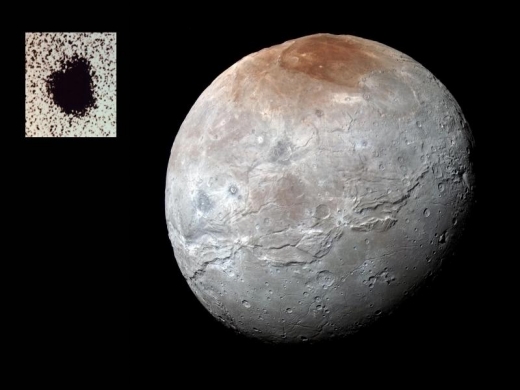
Image: What a difference 40 years makes. An enhanced color image of Charon from data gathered by the New Horizons spacecraft in 2015 shows a range of diverse surface features, significantly transforming our view of a moon discovered in 1978 as a “bump” on Pluto (inset) in a set of grainy telescope images. Credit: U.S. Naval Observatory; NASA/Johns Hopkins University Applied Physics Laboratory/Southwest Research Institute.
The Charon image that follows shows the fractures and canyons of Charon’s Pluto-facing hemisphere, a belt that stretches fully 1600 kilometers across the face of the moon and most likely onto the far side. Stark evidence of geological upheaval. the terrain is four times as long as the Grand Canyon and in places twice as deep, as this JHU/APL news release points out. New Horizons deputy project manager Cathy Olkin (SwRI) sees this tectonic belt as evidence that Charon once had a subsurface ocean whose eventual freezing cracked the surface.
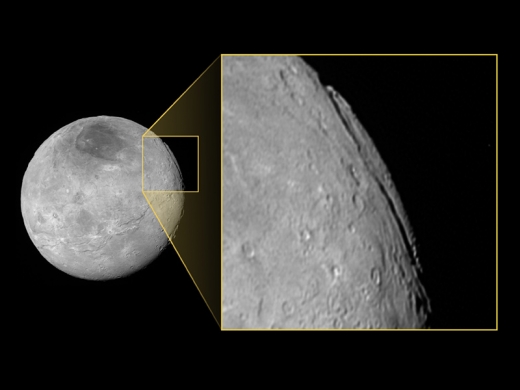
Image: This great canyon system stretches more than 1,600 kilometers across the entire face of Charon and likely around onto Charon’s far side. Four times as long as the Grand Canyon, and twice as deep in places, these faults and canyons indicate a titanic geological upheaval in Charon’s past. Credit: JHU/APL.
So this post is all about who we were 40 years ago and who we are now, what we knew back then and how dogged persistence and extraordinary coincidence could propel us to today’s stunning views of Charon. “When you go from this little blur in which you don’t actually see anything, to the enormous detail New Horizons sent back,” says Christy, “it’s incredible.”

On Galactic Migration

Yesterday I looked at the prospect of using technology to move entire stars, spurred on by Avi Loeb’s recent paper “Securing Fuel for Our Frigid Cosmic Future.” As Loeb recounts, he had written several papers on the accelerated expansion of the universe, known to be happening since 1998, and the resultant ‘gloomy cosmic isolation’ that it portends for the far future. It was Freeman Dyson who came up with the idea that a future civilization might move widely spaced stars, concentrating them into a small enough volume that they would remain bound by their own gravity. This escape from cosmic expansion has recently been explored by Dan Hooper, who likewise considers moving stellar populations.
Image: Harvard’s Avi Loeb, whose recent work probes life’s survival at cosmological timescales.
I gave a nod yesterday to the star-moving ideas of Leonid Shkadov, who suggested a ‘Shkadov thruster’ that would use the momentum of stellar photons to operate, but Loeb pointed out how inefficient the process would be. Better to harvest stellar energy more directly, as Hooper was proposing. This reminds me of Fritz Zwicky’s own ideas about moving stars. In his book Discovery, Invention, Research through the Morphological Process (Macmillan, 1969) the physicist developed ideas he had first presented in lectures at Oxford University in 1948 on how to reach Alpha Centauri.
The fiercely independent Zwicky coined the term ‘stellar propulsion’ at Oxford and went on to describe using the matter of the Sun itself as nuclear propellant. In his later work, he followed up on the idea, the plan being to turn our planet, pulled along with the Sun, into the ultimate generation ship. I have to pause to quote Zwicky on this, from a June, 1961 article in Engineering and Science called “The March Into Inner and Outer Space”:
In order to exert the necessary thrust on the sun, nuclear fusion reactions could be ignited locally in the sun’s material, causing the ejection of enormously high-speed jets. The necessary nuclear fusion can probably best be ignited through the use of ultrafast particles being shot at the sun. To date there are at least two promising prospects for producing particles of colloidal size with velocities of a thousand kilometers per second or more. Such particles, when impinging on solids, liquids, or dense gases, will generate temperatures of one hundred million degrees Kelvin or higher-quite sufficient to ignite nuclear fusion. The two possibilities for nuclear fusion ignition which I have in mind do not make use of any ideas related to plasmas, and to their constriction and acceleration in electric and magnetic fields.
Like Loeb, Zwicky (1898-1974) liked to think big. The discoverer of 122 supernovae, he came to be interested in galactic clusters, and in particular the Coma cluster. Here his reputation for being ahead of his time is on full display, for he discovered that the mass of the cluster was far too little to produce the gravitational effects observed. In other words, something was keeping the cluster together beside visible matter. This anticipation of what we today call ‘dark matter’ was one Zwicky suggested could be studied by another cutting edge idea, gravitational lensing.

I wish I had known Zwicky, who surely would have jumped into the ideas in Avi Loeb’s paper with gusto. Loeb argues that moving stars to concentrate them into smaller regions is ultimately not necessary. If we want to avoid the cosmic fate awaiting us, with galaxies winking out in the distant future as they move beyond the visible universe, we should think in terms of locating the places where stars are already the most concentrated, the huge galactic clusters. Zwicky, the force behind a six-volume catalog of 30,000 galaxies based on the Palomar Observatory Sky Survey, was just the man to appreciate this insight, and doubtless to add a few of his own.
The Coma cluster that was the subject of Zwicky’s observations on ‘dark matter’ is about six times further away than the Virgo cluster, but both are laden with resources. Given that accelerated cosmic expansion should be detectable by any sufficiently advanced civilization, these galactic clusters — massive reservoirs of fuel, as Loeb calls them — should be desirable places for migration, just as in our own history civilizations settled around rivers and lakes.
The benefits of moving a civilization into a galactic cluster are numerous, writes Loeb:
Once settled in a cluster, a civilization could hop from one star to another and harvest their energy output just like a butterfly hovering over flowers in a hunt for their nectar. The added benefit of naturally-produced clusters is that they contain stars of all masses, much like a cosmic bag that collected everything from its environment. The most common stars weigh a tenth of the mass of the Sun, but are expected to shine for a thousand times longer because they burn their fuel at a slower rate. Hence, they could keep a civilization warm for up to ten trillion years into the future.
As Loeb goes on to point out, nearby red dwarfs like Proxima Centauri and TRAPPIST-1 have already been found to have rocky, Earth-sized planets around them in or near the habitable zone. If this is the case with nearby stars we have just begun to examine, the implication is that planets are likely around most. This kind of star, the M-dwarf comprising up to 80 percent of all stars in the Milky Way, appears made to order for civilizations dependent on liquid water. Note the vivid image above, by the way: A civilization harvesting energy output like a butterfly hovering over flowers. Like fellow astronomer Greg Laughlin, Loeb is an uncommonly fine wordsmith.
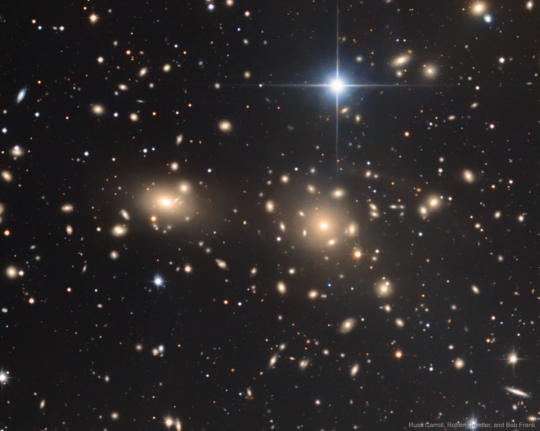
Image: Almost every object in the above photograph is a galaxy. The Coma Cluster of galaxies pictured here is one of the densest clusters known – it contains thousands of galaxies. Each of these galaxies houses billions of stars – just as our own Milky Way galaxy does. Although nearby when compared to most other clusters, light from the Coma Cluster still takes hundreds of millions of years to reach us. In fact, the Coma Cluster is so big it takes light millions of years just to go from one side to the other. Most galaxies in Coma and other clusters are ellipticals, while most galaxies outside of clusters are spirals. The nature of Coma’s X-ray emission is still being investigated. Credit: Russ Carroll, Robert Gendler, & Bob Franke; Dan Zowada Memorial Observatory.
Naturally we are talking about very long-term solutions to a far-distant problem when we discuss moving a civilization to the most useful galactic cluster. The question comes down to whether it would be possible to travel, say, a hundred million light years within the age of the universe. To do this, Loeb says, it would be necessary to exceed one percent of the speed of light. At these speeds, no relativistic time dilation can shorten the journey for its participants. These would be civilization-spanning journeys by cultures capable of surviving on geological timescales.
But let’s mimic Fritz Zwicky and let our imaginations loose. Zwicky proposed that a moving Sun could reach Alpha Centauri in approximately 50 human generations. Loeb ratchets up the challenge in a grand way, though leaving the method of travel up to future scientists. A bonus in going where the fuel is: We might expect to find other civilizations that have made the same decision, with whom we could share cultures and technologies. Like individual species, perhaps all life-forms capable of making the journey will want to congregate around watering holes like these, a far future echo of the history of life on a planet we may or may not be taking with us.
The paper is Loeb, “Securing Fuel for Our Frigid Cosmic Future” (preprint).

Cosmic Engineering and the Movement of Stars
Avi Loeb’s new foray into the remote future had me thinking of the Soviet physicist Leonid Shkadov, whose 1987 paper “Possibility of Controlling Solar System Motion in the Galaxy” (citation below) discussed how an advanced civilization could get the Sun onto a new trajectory within the galaxy. Why would we want to do this? Shkadov could imagine reasons of planetary defense, a star being moved out of the way of a close encounter with another star, perhaps.
All of this may remind science fiction readers of Robert Metzger’s novel CUSP (Ace, 2005), which sees the Sun driven by a massive propulsive jet. A more recent referent is Gregory Benford and Larry Niven’s novels Bowl of Heaven (Tor, 2012) and ShipStar (2014), in which a star is partially enclosed by a Dyson sphere and used to explore the galaxy. In 1973, Stanley Schmidt would imagine Earth itself being moved to M31 as a way of avoiding an explosion in the core of the Milky Way that threatens all life (Sins of the Fathers, first published as a serial in Analog).
Loeb’s paper mentions technologies for moving stars because several recent proposals involve this kind of ‘cosmic engineering’ to change civilizational outcomes. The accelerated expansion of the universe will, after the universe has aged by a factor of 10, make all stars outside the Local Group of galaxies disappear as they recede. The process continues with continued acceleration. Wait long enough and we fall prey to cosmic winter, and as Loeb writes:
Following the lesson from Aesop’s fable “The Ants and the Grasshopper,” it would be prudent to collect as much fuel as possible before it is too late, for the purpose of keeping us warm in the frigid cosmic winter that awaits us. In addition, it would be beneficial for us to reside in the company of as many alien civilizations as possible with whom we could share technology, for the same reason that animals feel empowered by congregating in large herds.
There are places where we might do this, says Loeb, and I’ll talk about his ideas on them tomorrow. For today, note that in response to his previous papers on the oncoming ‘cosmic isolation,’ Freeman Dyson proposed to Loeb his own project that would move stars, bringing large-scale formations of stars down to a more manageable volume so that they will be bound by their own gravity. Closely spaced, the stellar collection avoids being dissipated in the accelerated expansion of the cosmos. And it turns out that Dan Hooper (University of Chicago) has also been pondering induced stellar motion, using the energy output of stars to cluster large numbers of them into an astronomically tight radius so that their energies can be harvested.
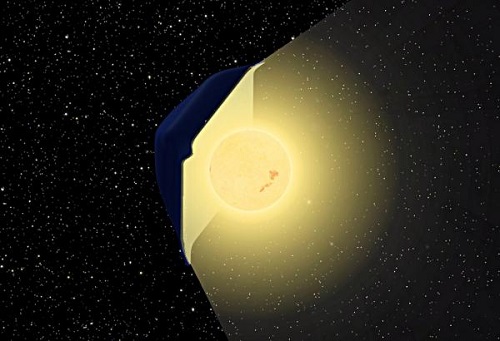
Image: A Shkadov thruster as conceived by the artist Steve Bowers.
Like Dyson and Loeb, Hooper has his eye on the acceleration of cosmic expansion and its consequences. So what kind of ‘stellar engines’ can we envision that could move objects as large as stars? Leonid Shkadov suggested using a star’s radiation pressure. The Shkadov thruster extracts energy from the star by using a vast mirror to take advantage of photon momentum. Let me turn back to an earlier post to reprint a diagram that Duncan Forgan uses in describing a Shkadov thruster. Forgan (University of Edinburgh) points out the difference between these thrusters and Dyson spheres, the latter being spherical and shaped so as to balance gravitational forces on the sphere by way of collecting a maximum amount of stellar energy. But here is the Shkadov thruster as diagrammed by Forgan:
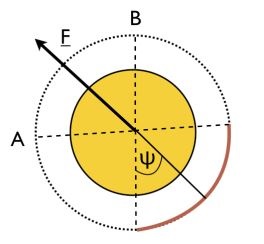
Image: This is Figure 1 from Duncan Forgan’s paper “On the Possibility of Detecting Class A Stellar Engines Using Exoplanet Transit Curves.” Caption: Diagram of a Class A Stellar Engine, or Shkadov thruster. The star is viewed from the pole – the thruster is a spherical arc mirror (solid line), spanning a sector of total angular extent 2ψ. This produces an imbalance in the radiation pressure force produced by the star, resulting in a net thrust in the direction of the arrow. Credit: Duncan Forgan.
Thus the whole idea of the Shkadov thruster is not balance but imbalance. And Forgan goes on to say this about the idea:
In reality, the refected radiation will alter the thermal equilibrium of the star, raising its temperature and producing the above dependence on semi-angle. Increasing ψ increases the thrust, as expected, with the maximum thrust being generated at ψ = π radians. However, if the thruster is part of a multi-component megastructure that includes concentric Dyson spheres forming a thermal engine, having a large ψ can result in the concentric spheres possessing poorer thermal efficiency.
Efficient or not, Shkadov thrusters interest Forgan as a possible SETI detection (Hooper also notes the possibility). Like Dyson spheres, their sheer scale and unusual features could make them visible in a lightcurve, perhaps with the aid of radial velocity follow-ups. Arguing against the idea, though, is the fact that the Shkadov thruster is probably not the technology our hypothetical future civilization would use to move its star (or stars).
I found this out when I wrote Avi Loeb in reaction to his new paper and mentioned the Shkadov idea. Loeb found Dan Hooper’s ideas (in “Life Versus Dark Energy: How An Advanced Civilization Could Resist the Accelerating Expansion of the Universe,” citation below) to be a better solution to the problem. Here is what Loeb told me in our email exchange yesterday:
The use of the momentum associated with the radiation emitted by the star for its propulsion, as envisioned in Shkadov’s thruster, is much less efficient than using the energy associated with same radiation. The radiation momentum equals its energy divided by the speed of light, c. However, the momentum gained by converting this energy to the kinetic energy of a massive object moving at a speed v is larger by a factor of 2(c/v). This is a huge factor of which Dan Hooper is taking advantage to argue that Sun-like stars can reach a percent of the speed light, 0.01c, in a billion years. If he would have used the momentum of the light emitted by the star as in Shkadov’s thruster, then the attainable speed would have been a hundred times smaller, only of order 30 km/s (similar to the speed of chemical rockets), and the journey being contemplated would have not been feasible. During the age of the Universe (10 billion years) one would only be able to traverse a million light years and not leave the Local Group of galaxies. This is not sufficient for gaining more fuel than available within the Local Group of galaxies.
Thus the problem of the Shkadov thruster: By using the momentum of stellar photons, Shkadov loses efficiency. Loeb adds: “One way to improve the efficiency of Shkadov’s thruster (by employing the energy and not the momentum of the star’s radiation) is to harvest the energy from the star through a Dyson sphere and then use it to ablate its surface on one side, generating a rocket effect.” This seems to be what Dan Hooper has in mind in his paper. The civilization in question would harvest the energy of stars through Dyson spheres that, quoting Hooper, “…use the collected energy to propel the captured stars, providing new and potentially distinctive signatures of an advanced civilization in this stage of expansion and stellar collection.”
Hooper has a SETI prospect in mind, while also thinking about collecting sources of energy, maximizing its amount in the form of starlight by a factor of several thousand. It is this prospect that interests Loeb. His paper makes the case that we already have massive reservoirs of fuel in the visible universe in the form of galactic clusters, each containing the equivalent of 1000 Milky Ways. Perhaps, then, we need no star-moving and collection project a la Hooper or Dyson, but rather need to think about reaching a galactic cluster for our fuel. Given the magnitude of that challenge, whether or not we take our home star along is inconsequential.
The speculative buzz I get from this is science fictional indeed. The nearest cluster is Virgo, whose center is some 50 million light years away, with the Coma cluster six times farther still. Thinking in terms of a civilization that could cross such gulfs takes us into Olaf Stapledon territory, a region of spacetime with which I share Loeb’s obvious fascination. I’m running out of time today, but want to look deeper into this with the help of Loeb’s paper tomorrow. I’ll also have more thoughts on ‘stellar engines’ and their origins.
Avi Loeb’s new paper is “Securing Fuel for Our Frigid Cosmic Future” (preprint). Leonid Shkadov’s paper on the Shkadov thruster is “Possibility of controlling solar system motion in the galaxy,” 38th Congress of IAF,” October 10-17, 1987, Brighton, UK, paper IAA-87-613. The Forgan paper is “On the Possibility of Detecting Class A Stellar Engines Using Exoplanet Transit Curves,” accepted at the Journal of the British Interplanetary Society (preprint). The Hooper paper is “Life Versus Dark Energy: How An Advanced Civilization Could Resist the Accelerating Expansion of the Universe” (2018). Preprint.

On Potentially Habitable Moons
Looking through a recent Astrophysical Journal paper on gas giants in the habitable zone of their stars, I found myself being diverted by the distinction between a conservative habitable zone (CHZ) and a somewhat more optimistic one (OHZ). Let’s pause briefly on this, because these are terms that appear frequently enough in the literature to need some attention.
The division works like this (and I’ll send you to the paper for references on the background work that has developed both concepts): The OHZ in our Solar System is considered to be roughly 0.71 to 1.8 AU, which sees Venus as the inner cutoff (a world evidently barren for at least a billion years) and Mars as the outer edge, given that it appears to have been habitable in the early days of the system, perhaps some 3.8 billion years ago. ‘Habitable’ in both HZ categories is defined as the region around a star where water can exist in a liquid state on a planet with sufficient atmospheric pressure (James Kasting has a classic 1993 paper on all this).
The CHZ’s inner edge is considered to be at the ‘runaway greenhouse limit,’ where the breakdown of water molecules by solar radiation allows free hydrogen atoms to escape, drying out the planet at approximately 0.99 AU in our own system. Its outer edge, says the paper:
…consists of the maximum greenhouse effect, at 1.7 AU in our solar system, where the temperature on the planet drops to a point where CO2 will condense permanently, which will in turn increase the planet’s albedo, thus cooling the planet’s surface to a point where all water is frozen (Kaltenegger & Sasselov 2011).
It goes without saying that boundaries like these are going to vary from one planetary system to another, and it’s likewise clear that most of our thinking about habitable zone planets has gone in the direction of small rocky worlds as we mount the search for Earth analogues. What Stephen Kane (University of Southern Queensland), working with an undergraduate student at the university named Michelle Hill as well as colleagues at the University of California, Riverside has done is to identify 121 giant planets in Kepler data that could host habitable moons.
To be sure, the gas giants themselves aren’t considered candidates for life as we know it (though obviously we can’t rule out exotic species adapted to extreme conditions, like Edwin Salpeter’s ‘gasbags,’ free-floating lifeforms that might populate dense atmospheres — see Edwin Salpeter and the Gasbags of Jupiter for more). But the real focus is on those rocky moons that occur in such abundance in our own system.
“There are currently 175 known moons orbiting the eight planets in our solar system. While most of these moons orbit Saturn and Jupiter, which are outside the Sun’s habitable zone, that may not be the case in other solar systems,” says Kane. “Including rocky exomoons in our search for life in space will greatly expand the places we can look.”
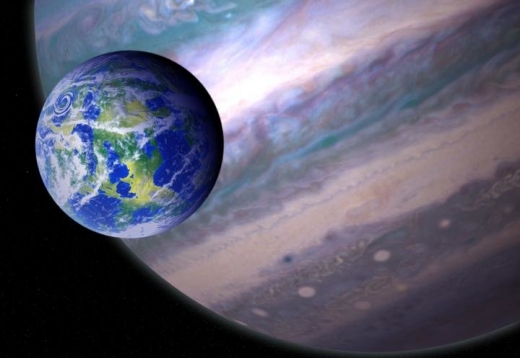
Image: This is an artist’s illustration of a potentially habitable exomoon orbiting a giant planet in a distant solar system. Credit: NASA GSFC: Jay Friedlander and Britt Griswold.
As we consider the different dimensions of habitable zones around other stars, we should also keep in mind the fact that the moons that may emerge in these systems can be as various as our own. Earth’s Moon, for example, seems to be the result of a giant impact early in the system’s formation. Most moons are thought to have formed by accretion within the dust disks around planets, but others can be captured by a planet’s gravitational pull — Triton seems to be an example of this. Thus we could find moons of considerably different composition than their host planet. Considering how many moons we see orbiting our gas giants, the assumption that moons exist around other such worlds in exoplanetary systems seems reasonable.
We still have no exomoon detections, but the search continues, and I always scan the latest papers from the Hunt for Exomoons with Kepler project that David Kipping runs with anticipation, along with those of exomoon theorist René Heller. Having a database of the giant planets we’ve identified thus far as being in the habitable zone of their star may help us target future observations to refine the expected properties of their moons, assuming these exist. Such moons would receive energy from the primary star, of course, but would also receive reflected radiation from the planet they orbit. René Heller has proposed that exomoons in a habitable zone could provide a better environment for life than Earth itself. Let me quote the Hill paper:
Exomoons have the potential to be what [Heller] calls “super-habitable” because they offer a diversity of energy sources to a potential biosphere, not just a reliance on the energy delivered by a star, like earth. The biosphere of a super-habitable exomoon could receive energy from the reflected light and emitted heat of its nearby giant planet or even from the giant planet’s gravitational field through tidal forces. Thus exomoons should then expect to have a more stable, longer period in which the energy received could maintain a livable temperate surface condition for life to form and thrive in.
Discussing the difficulties of exomoon detection, such as the fact that multiple moons around a single planet may eliminate a useful transit timing signal (this is Jean Schneider’s work) and the problems of direct imaging, it’s interesting to see that microlensing remains a candidate. It’s also intriguing to ponder the fate of exomoons, as this paper does, in terms of migrating gas giants and the likelihood that their moons will be lost. We still have much to learn about the movement of giant planets and the effect of their migration upon their own moons as well as other planets.
Once we have a firm exomoon detection, we can begin to characterize the possibilities. As we await improvements in our technology, deepening our knowledge of potential exomoon host planets is the best we can do, and that would begin, as this paper suggests, with radial velocity follow-up observations on gas giant habitable zone candidates like the ones compiled by the authors.
The paper is Hill et al., “Exploring Kepler Giant Planets in the Habitable Zone,” The Astrophysical Journal, 2018; 860 (1): 67. Abstract / preprint. The Kasting paper mentioned above is “Habitable Zones around Main Sequence Stars,” Icarus Vol. 101, Issue 1 (1993), pp. 108-128 (abstract). For René Heller’s work on ‘superhabitable’ moons, see Heller & Armstrong, “Superhabitable Worlds,” Astrobiology January 2014 (preprint). Jean Schneider’s paper on exomoon detection problems is Schneider & Sartoretti, “On the detection of satellites of extrasolar planets with the method of transits,” Astronomy & Astrophysics. Suppl. Ser. Vol. 134, No. 3 (1 February), pp. 553-560 (abstract).

